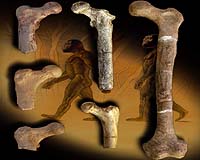| . |  |
. |
Cold Spring Harbor NY (SPX) May 26, 2010 Genetic variation due to DNA mutation is a driving force of adaptation and evolution, as well as a contributing factor to disease. However, the mechanisms governing DNA mutation rate are not well understood. In a report published online in Genome Research , researchers have identified intrinsic properties of DNA that influence mutation rate, shedding light on mechanisms involved in genome maintenance and potentially disease. Some DNA mutations are subject to natural selection, either conferring a biological advantage that is selected for, or a negative effect that is selected against. Mutations not under selection are said to be neutral, and the rate at which neutral mutations accumulate is reflective of the true DNA mutation rate. Researchers can estimate this mutation rate by comparing neutrally evolving sequences in species that share a common ancestor. Interestingly, the neutral mutation rate can vary significantly between different regions of chromosomes. This suggests that the context of the DNA influences how rapidly it accumulates mutations. Sequence high in pairs of the bases C and G (CpGs) where the C's are chemically modified, have been positively correlated with mutation rate. However, the chemical modification of CpGs makes them prone to mutation themselves, and with time they are eliminated from neutrally evolving sequences. NIH researchers Jean-Claude Walser and Anthony Furano have taken advantage of this property to investigate the role of CpGs on the mutation rate of non-CpG DNA, by comparing "old" and "young" sequences. Walser and Furano compared the CpG content and DNA changes in inactive L1 retrotransposons shared by humans and chimpanzees. These ancient DNA sequences that had previously expanded in our common ancestor to multiple copies interspersed throughout the genome, but are now extinct "DNA fossils" that are neutrally evolving. The researchers had previously noted that the older L1s have a lower CpG content than the younger sequences as expected, but here they observed two particularly striking features: "The overall mutation rate in the older fossil sequences dropped dramatically," said Furano, indicating a certain CpG content threshold is required to affect the non-CpG mutation rate. "And most provocatively, the types of mutations changed significantly." This means that CpGs are not only promoting mutations, but they are also influencing how the non-CpG sequences around them are being mutated, an extension of what the authors call the "CpG effect." These findings strongly support the hypothesis that the co-variation of CpG content and non-CpG mutation rate is a property of the DNA sequence itself, and not a result of the chromosomal location. "Intriguingly, the CpG effect revealed by our studies mimics the altered mutational state that has been demonstrated for certain cancers," Furano noted. Furthermore, the authors expect that this work will open the door to future studies investigating the mechanisms by which CpGs exert their influence on mutation rate and how this is involved in the critical process of genome maintenance. Scientists from National Institute of Diabetes and Digestive and Kidney Diseases (NIDDK) contributed to this study.
Share This Article With Planet Earth
Related Links Cold Spring Harbor Laboratory Darwin Today At TerraDaily.com
 Possible New Class Of Supernovae Puts Calcium In Your Bones
Possible New Class Of Supernovae Puts Calcium In Your BonesBerkeley CA (SPX) May 25, 2010 In the past decade, robotic telescopes have turned astronomers' attention to scads of strange exploding stars, one-offs that may or may not point to new and unusual physics. But supernova (SN) 2005E, discovered five years ago by the University of California, Berkeley's Katzman Automatic Imaging Telescope (KAIT), is one of eight known "calcium-rich supernovae" that seem to stand out as hors ... read more |
|
| The content herein, unless otherwise known to be public domain, are Copyright 1995-2010 - SpaceDaily. AFP and UPI Wire Stories are copyright Agence France-Presse and United Press International. ESA Portal Reports are copyright European Space Agency. All NASA sourced material is public domain. Additional copyrights may apply in whole or part to other bona fide parties. Advertising does not imply endorsement,agreement or approval of any opinions, statements or information provided by SpaceDaily on any Web page published or hosted by SpaceDaily. Privacy Statement |